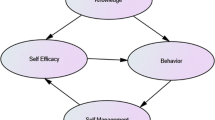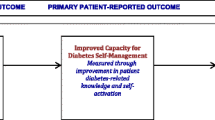Abstract
Persons from Somalia constitute the largest group of immigrants and refugees from Africa among whom diabetes-related health disparities are well documented. As one of the first steps toward developing a behavioral intervention to address diabetes among Somali immigrants and refugees, we administered a face to face interview-based survey to Somali and Latino adults with diabetes in a single community to assess diabetes knowledge, attitudes and behaviors. Respondents (N = 78) reported several barriers to optimal diabetes management for physical activity and glucose self-monitoring, as well as a high burden of disease and negative perceptions of diabetes. High participant engagement in disease management, self-efficacy, and social support were important assets. Similarities suggest that the shared experiences of immigration and related systemic socioeconomic and linguistic factors play a significant role in the understanding and self-management of diabetes in these populations. Together with previously collected qualitative work, the survey findings will inform development of a behavioral intervention to improve outcomes and reduce diabetes-related health disparities among immigrant and refugee groups to the U.S.
Similar content being viewed by others
References
Singh GK, Miller BA. Health, life expectancy, and mortality patterns among immigrant populations in the United States. Can J Public Health. 2004;95:114–21.
The foreign born population in the United States: 2003. Current Population Reports, P20-551. US Census Bureau 2004. http://www.census.gov/population/www/socdemo/foreign/cps2003.html. Accessed 30 August 2014.
Place of birth of the foreign-born population: 2009. American Community Survey 2009, ACSBR/09-15. U.S. Census Bureau, 2010. http://www.census.gov/population/www/socdemo/foreign/reports.html. Accessed 30 Aug 2014.
US Population Projections: 2005-2050. Pew Research Center, 2008. http://www.pewresearch.org/files/reports/85.pdf. Accessed 15 July 2013.
Steven Ruggles JTA, Katie Genadek, Ronald Goeken, Matthew B. Schroeder, and Matthew Sobek. Integrated Public Use Microdata Series: Version 5.0 [Machine-readable database]. Minneapolis: University of Minnesota. 2010.
CDC. Centers for Disease Control and Prevention. National diabetes fact sheet: national estimates and general information on diabetes and prediabetes in the United States. In: Services USDoHaH, ed. Atlanta, GA; 2011.
Kirk JK, Passmore LV, Bell RA, et al. Disparities in A1C levels between Hispanic and non-Hispanic white adults with diabetes: a meta-analysis. Diabetes Care. 2008;31:240–6.
Kurian AK, Cardarelli KM. Racial and ethnic differences in cardiovascular disease risk factors: a systematic review. Ethn Dis. 2007;17:143–52.
Njeru JW, Tan EM, St Sauver J, et al. High rates of diabetes mellitus, pre-diabetes and obesity among somali immigrants and refugees in minnesota: a retrospective chart review. J Immigr Minor Health. 2015. doi:10.1007/s10903-015-0280-3.
Wieland ML, Morrison TB, Cha SS, Rahman AS, Chaudhry R. Diabetes care among Somali immigrants and refugees. J Community Health. 2012;37:680–4.
Schneiderman N, Llabre M, Cowie CC, et al. Prevalence of diabetes among hispanics/latinos from diverse backgrounds: the hispanic community health study/study of latinos (HCHS/SOL). Diabetes Care. 2014;37:2233–9.
Selvin E, Parrinello CM, Sacks DB, Coresh J. Trends in prevalence and control of diabetes in the United States, 1988–1994 and 1999–2010. Ann Intern Med. 2014;160:517–25.
Dallo FJ, Wilson FA, Stimpson JP. Quality of diabetes care for immigrants in the US. Diabetes Care. 2009;32:1459–63.
Sullivan LV, Hicks P, Salazar G, Robinson CK. Patient beliefs and sense of control among Spanish-speaking patients with diabetes in northeast Colorado. J Immigr Minor Health. 2010;12:384–9.
Hubert HB, Snider J, Winkleby MA. Health status, health behaviors, and acculturation factors associated with overweight and obesity in Latinos from a community and agricultural labor camp survey. Prev Med. 2005;40:642–51.
Weiler DM, Crist JD. Diabetes self-management in the migrant Latino population. Hisp Health Care Int. 2007;5(1):27–33.
Sadowski D, Devlin M, Hussain A. Diabetes self-management activities for Latinos living in non-metropolitan rural communities: a snapshot of an underserved rural state. J Immigr Minor Health. 2012;14:990–8.
Carbone ET, Rosal MC, Torres MI, Goins KV, Bermudez OI. Diabetes self-management: perspectives of Latino patients and their health care providers. Patient Educ Couns. 2007;66:202–10.
Hatcher E, Whittemore R. Hispanic adults’ beliefs about type 2 diabetes: clinical implications. J Am Acad Nurse Pract. 2007;19:536–45.
Heuer L, Lausch C. Living with diabetes: perceptions of Hispanic migrant farmworkers. J Community Health Nurs. 2006;23:49–64.
Rosal MC, Olendzki B, Reed GW, Gumieniak O, Scavron J, Ockene I. Diabetes self-management among low-income Spanish-speaking patients: a pilot study. Ann Behav Med. 2005;29:225–35.
White RO, Gebretsadik T, Kripalani S, Rothman RL. The diabetes literacy and numeracy educational toolkit latino (DLNET-Latino): A pre-post feasibility study of an educational intervention for Latino adults with diabetes. J Gen Intern Med 2012. In: Conference: 35th annual meeting of the society of general internal medicine, SGIM 2012 Orlando, FL United States. Conference Start: 20120509 Conference End: 20120512. Conference Publication: (var.pagings). 27:S317.
Thompson JR, Horton C, Flores C. Advancing diabetes self-management in the Mexican American population: a community health worker model in a primary care setting. Diabetes Educ. 2007;33(Suppl 6):159S–65S.
Waidmann TA, Rajan S. Race and ethnic disparities in health care access and utilization: an examination of state variation. Med Care Res Rev. 2000;57(Suppl 1):55–84.
Howe Hasanali S, De Jong GF, Graefe DR. Hispanic-Asian Immigrant Inequality in Perceived Medical Need and Access to Regular Physician Care. J Immigr Minor Health. 2014. doi:10.1007/s10903-014-0137-1.
Nguyen J, Hernández MG, Saetermoe CL, Suárez-Orozco C. An ethical frame for research with immigrant families. New Dir Child Adolesc Dev. 2013;2013:1–7.
Hernández MG, Nguyen J, Casanova S, Suárez-Orozco C, Saetermoe CL. Doing no harm and getting it right: guidelines for ethical research with immigrant communities. New Dir Child Adolesc Dev. 2013;2013:43–60.
Wieland ML, Nelson J, Palmer T, et al. Evaluation of a tuberculosis education video among immigrants and refugees at an adult education center: a community-based participatory approach. J Health Commun. 2013;18:343–53.
Rochester Healthy Community Partnership. http://www.rochesterhealthy.org/.
Roglic G, Unwin N, Bennett PH, et al. The burden of mortality attributable to diabetes: realistic estimates for the year 2000. Diabetes Care. 2005;28:2130–5.
Wieland ML, Tiedje K, Meiers SJ, et al. Perspectives on physical activity among immigrants and refugees to a small urban community in Minnesota. J Immigr Minor Health. 2013;17(1):263–275.
Wieland ML, Weis JA, Palmer T, et al. Physical activity and nutrition among immigrant and refugee women: a community-based participatory research approach. Womens Health Issues. 2012;22:e225–32.
Diabetes history survey (DMH). http://www.med.umich.edu/mdrtc/profs/survey.html. Accessed 30 Aug2014.
Fitzgerald JT, Davis WK, Connell CM, Hess GE, Funnell MM, Hiss RG. Development and validation of the diabetes care profile. Eval Health Prof. 1996;19:208–30.
Toobert DJ, Hampson SE, Glasgow RE. The summary of diabetes self-care activities measure: results from 7 studies and a revised scale. Diabetes Care. 2000;23:943–50.
Garcia AA, Villagomez ET, Brown SA, Kouzekanani K, Hanis CL. The starr county diabetes education study: development of the Spanish-language diabetes knowledge questionnaire. Diabetes Care. 2001;24:16–21.
Hess GE, Davis WK, Harrison RV. A diabetes psychosocial profile. Diabetes Educ. 1986;12:135–40.
Cerkoney KA, Hart LK. The relationship between the health belief model and compliance of persons with diabetes mellitus. Diabetes Care. 1980;3:594–8.
Hurley AC. The health belief model: evaluation of a diabetes scale. Diabetes Educ. 1990;16:44–8.
Brownlee-Duffeck M, Peterson L, Simonds JF, Goldstein D, Kilo C, Hoette S. The role of health beliefs in the regimen adherence and metabolic control of adolescents and adults with diabetes mellitus. J Consult Clin Psychol. 1987;55:139–44.
Walker RJ, Smalls BL, Hernandez-Tejada MA, Campbell JA, Egede LE. Effect of diabetes self-efficacy on glycemic control, medication adherence, self-care behaviors, and quality of life in a predominantly low-income, minority population. Ethn Dis. 2014;24:349–55.
Formea CM, Mohamed AA, Hassan A, et al. Lessons learned: cultural and linguistic enhancement of surveys through community-based participatory research. Prog Community Health Partnersh. 2014;8:331–6.
World Health Organization Process of translation and adaptation of instruments. 2007. http://www.who.int/substance_abuse/research_tools/translation/en/. Accessed 23 Aug 2013.
U.S. Census Bureau: State and County QuickFacts. Last Revised: Thursday, 04-Dec-2014 09:46:42 EST. 2013. http://quickfacts.census.gov/qfd/states/27/2754880.html.
U.S. Census Bureau: State and County QuickFacts. Data derived from Population Estimates, American Community Survey, Census of Population and Housing, County Business Patterns, Economic Census, Survey of Business Owners, Building Permits, Census of Governments Last Revised: Tuesday, 24 Mar 2015. Accessed 24 Mar 2015.
Minnesota Department of Administration. Immigrants to Minnesota by region and selected country of birth. 2010. http://www.demography.state.mn.us/resource.html?Id=18679.
Hawley NC, Wieland ML, Weis JA, Sia IG. Perceived impact of human subjects protection training on community partners in community-based participatory research. Prog Community Health Partnersh. 2014;8:241–8.
Rubin RR, Peyrot M. Quality of life and diabetes. Diabetes Metab Res Rev. 1999;15:205–18.
Oliva J, Fernandez-Bolanos A, Hidalgo A. Health-related quality of life in diabetic people with different vascular risk. BMC Public Health. 2012;12:812.
Lanting LC, Joung IMA, Vogel I, Bootsma AH, Lamberts SWJ, Mackenbach JP. Ethnic differences in outcomes of diabetes care and the role of self-management behavior. Patient Educ Couns. 2008;72:146–54.
Vest BM, Kahn LS, Danzo A, et al. Diabetes self-management in a low-income population: impacts of social support and relationships with the health care system. Chronic Illn. 2013;9:145–55.
Wen LK, Parchman ML, Shepherd MD. Family support and diet barriers among older Hispanic adults with type 2 diabetes. Fam Med. 2004;36:423–30.
Browne JL, Ventura A, Mosely K, Speight J. ‘I call it the blame and shame disease’: a qualitative study about perceptions of social stigma surrounding type 2 diabetes. BMJ Open. 2013;3:e003384.
Arora S, Marzec K, Gates C, Menchine M. Diabetes knowledge in predominantly Latino patients and family caregivers in an urban emergency department. Ethn Dis. 2011;21:1–6.
Edwards M, Wood F, Davies M, et al. ‘Distributed health literacy’: longitudinal qualitative analysis of the roles of health literacy mediators and social networks of people living with a long-term health condition. Health Expect. 2015;18(5):1180–1193. doi:10.1111/hex.12093.
Zareban I, Karimy M, Niknami S, Haidarnia A, Rakhshani F. The effect of self-care education program on reducing HbA1c levels in patients with type 2 diabetes. J Educ Health Promot. 2014;3:123.
Baghianimoghadam MH, Hadavandkhani M, Mohammadi M, Fallahzade H, Baghianimoghadam B. Current education versus peer-education on walking in type 2 diabetic patients based on Health Belief Model: a randomized control trial study. Rom J Intern Med. 2012;50:165–72.
Dagogo-Jack S, Funnell MM, Davidson J. Barriers to achieving optimal glycemic control in a multi-ethnic society: a US focus. Curr Diabetes Rev. 2006;2:285–93.
Onwudiwe NC, Mullins CD, Winston RA, et al. Barriers to self-management of diabetes: a qualitative study among low-income minority diabetics. Ethn Dis. 2011;21:27–32.
Berkowitz SA, Meigs JB, DeWalt D, et al. Material need insecurities, control of diabetes mellitus, and use of health care resources: results of the measuring economic insecurity in diabetes study. JAMA Intern Med. 2015;175(2):257–265.
Jaspers L, Colpani V, Chaker L, et al. The global impact of non-communicable diseases on households and impoverishment: a systematic review. Eur J Epidemiol. 2015;30(3):163–188.
Author information
Authors and Affiliations
Corresponding author
Ethics declarations
Conflict of interest
The authors state that they have no conflicts of interest.
Rights and permissions
About this article
Cite this article
Njeru, J.W., Formea, C.M., Osman, A. et al. Diabetes Knowledge, Attitudes and Behaviors Among Somali and Latino Immigrants. J Immigrant Minority Health 18, 1432–1440 (2016). https://doi.org/10.1007/s10903-015-0335-5
Published:
Issue Date:
DOI: https://doi.org/10.1007/s10903-015-0335-5




